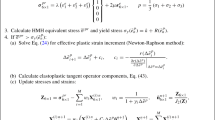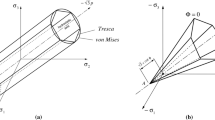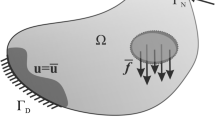Abstract
The numerical simulation of elastic-inelastic material behaviour is reviewed and an alternative method, i. e., an augmented Finite Element (FE) formulation is presented. For the augmented FE formulation, the history variables, which provide the information of inelastic deformations from previous time-steps, are represented as FE functions. The discretisation of the augmented system results in additional degrees of freedom (DOF). As a result, generally accepted standard formulations for evaluating inelastic deformations in a numeric sub-step can now be replaced by a fully coupled Newton method. Then, it is not required to solve additional local systems. Both numerical methods are exemplarily applied to a viscoplastic Perzyna-type regularisation of softening material behaviour within a geometrically linear approach in order to simulate the development of shear bands occurring in a tensile bar. Numerical studies prove comparative results, while exhibiting a computational speed-up for the augmented FE formulation.
Similar content being viewed by others
References
Ammann M (2005) Parallel finite element simulations of localization phenomena in porous media. Dissertation, Report No. II-11 of the Institute of Applied Mechanics (CE), University of Stuttgart, Stuttgart
Becker M, Miehe C (2005) Incompatibility induced nonlocal crystal plasticity. Proc Appl Math Mech (PAMM) 5: 259–260
Ehlers W (1995–2010) Vector and tensor calculus: an introduction. Lecture notes, Institute of Applied Mechanics (CE), University of Stuttgart, Stuttgart. http://www.mechbau.de
Ehlers W (2002) Foundations of multiphasic and porous materials. In: Ehlers W, Bluhm J (eds) Porous Media: Theory, Experiments and Numerical Applications. Springer, Berlin, pp 3–86
Engelen RAB, Geers MGD, Baaijens FPT (2003) Nonlocal implicit gradient-enhanced elasto-plasticity for the modelling of softening behaviour. Int J Plast 19: 403–433
Herres OM, Suiker ASJ, de Borst R (2002) A comparison between the Perzyna viscoplastic model and the Consistency viscoplastic model. Eur J Mech A, Solids 21: 1–12
Krabbenhoft K, Lyamin AV, Sloan SW, Wriggers P (2007) An interior-point algorithm for elastoplasticity. Int J Num Meth Eng 69: 592–626
Kulkarni DV, Tortorelli DA, Wallin M (2007) A Newton-Schur alternative to the consistent tangent approach in computational plasticity. Comput Meth Appl Mech Eng 196: 1169–1177
Liebe T, Steinmann P (2001) Theory and numerics of a thermodynamically consistent framework for geometrically linear gradient plasticity. Int J Num Meth Eng 51: 1437–1467
Lourenço PB, de Borst R, Rots JG (1997) A plane stress softening plasticity model for orthotropic materials. Int J Num Meth Eng 40: 4033–4057
Perzyna P (1966) Fundamental problems in viscoplasticity. Adv Appl Mech 9: 243–377
Simo J, Hughes TJR (1998) Computational Inelasticity. Springer, Berlin
Simo JC, Taylor RL (1985) Consistent tangent operators for rate-independent elastoplasticity. Comput Meth Appl Mech Eng 48: 101–118
Simo JC, Kennedy JG, Govindjee S (1988) Non-smooth multisurface plasticity and viscoplasticity. Loading/unloading conditions numerical algorithms. Int J Num Meth Eng 26: 2161–2185
Wieners C (2007) Nonlinear solution methods for infinitesimal perfect plasticity. Zeitschrift für Angewandte Mathematik und Mechanik (ZAMM) 87: 636–660
Author information
Authors and Affiliations
Corresponding author
Rights and permissions
About this article
Cite this article
Rempler, HU., Wieners, C. & Ehlers, W. Efficiency comparison of an augmented finite element formulation with standard return mapping algorithms for elastic-inelastic materials. Comput Mech 48, 551–562 (2011). https://doi.org/10.1007/s00466-011-0602-9
Received:
Accepted:
Published:
Issue Date:
DOI: https://doi.org/10.1007/s00466-011-0602-9




